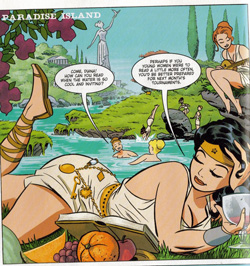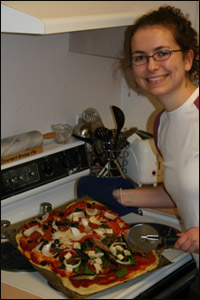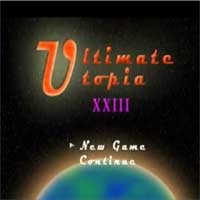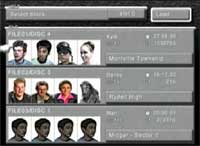At exactly one year ago today, OS.CB was born. Scant months after the (now defunct) Shrub.com Articles were being written, I realized that I wanted more than just one day every three months to shout from my soapbox. Couple that with my introduction to the feminist blogsphere and… well… here we are. Over the year this blog has grown and changed for the better; we’ve gained a contributor and lost one, crystalized into a site that discusses intersections between feminism and other areas, and become one of the many links in this wonderful community.
I’d like to thank Ariel for her contributions, all of my readers (both commenters and lurkers) for their support, and all of my blog friends who work hand in hand with me while we build our little niches on the net. So, thank you all, and please join with me in wishing our blog a very happy first birthday!
As part of the celebration, I’d like to highlight some of my favourite posts from this year.
On Feminism
June 28, 2005: Feminism is about Choice
Well, I rediscovered this little gem and decided to add it to my Feminism 101 links. It’s basically a rundown on why I think choice is an intrinsic part of feminism. I think this is where I began using my pet terms “cult of masculinity” and “cult of femininity”. Yay.
Highlight:
But, get this, feminism isn’t about hatred, it’s about giving people the choice on how to live their lives. It’s about letting women choose to use power tools, to read romance novels without shame, to work on the same level in the same jobs as men, to be valued for the work done at home and not be seen as “lazy” or “freeloaders” because they don’t earn a wage. It’s about letting men choose to play with Barbies, to watch sports on TV, to be able to enter “caring” professions without being branded a failure, to be able to contribute to the work done at home without being seen as some bumbling man incapable of even the easiest domestic tasks. It’s about seeing those who don’t fit into the binary of “man” and “woman” as people instead of freaks, to allow transsexuals to explore their gender identity without fear of being teased or worse, to stop the barbaric hospital procedures that force the intersexed children who are born with both a penis and a vagina into being “female” by removing their outward male organ, to let those uncomfortable with the implications of male and female exist as they are. It’s about all that, and much, much more.
November 22, 2005: Think women have achieved equality? Think again.
An extensive list of gender inequalities that exist in Western societies. Sadly, for its length it still only manages to touch the tip of the iceberg on the issues of equality (or the lack thereof).
Highlight:
Libby discusses her experiences with the “women are equal already†sentiment that many young people (and some older ones too) hold. I, in my typical fashion, went off on a rant about how much I hate that. And, again in my typical fashion, I want to take the opportunity to elaborate on my point.
Putting the “Geek” Back Into “Feminist”
April 28, 2005: Games Even Your Girlfriend Can Play!
Tired of all the lists of things that you, as a woman, are supposed to want out of whatever technology being hawked? Yeah, me too. The first of many in a category I later called “for her”, “Games Even Your Girlfriend Can Play!” is a deconstruction of the sexist language employed in an article of similar title.
Highlight:
Marginalization in the gaming industry is nothing new to me. I mean, having boobs and a vagina and identifying as female is obviously enough to exclude me from that Good Ol’ Boys Club™. If I do venture in, it must only be through a boyfriend (since all good boys and girls are heterosexual) who will introduce me to fluffy games, like Bejeweled and Nintendogs, which are not too hardcore for my weak constitution. Do I sound bitter? Well, after spending most of my twenty-two years seeing mainstream magazines, websites, and other gaming publications catering to guys, and only guys, I think I’ve earned a bit of bitterness. I don’t think it’s too much to ask for me to not have to go to a female-oriented gaming site in order to be included.
December 4, 2005: Because sexual harassment is hilarious
Video games are not real life, but they do intersect real life. Using the case study of a fan-made Japanese game, I discuss two intersections here: 1) drawing off of real life phenomena, and 2) sending messages to players.
Highlight:
He starts out really well with the humiliation angle; one of the best tools for control is shame. Humiliating a woman (or girl) by exerting ownership to her body (in this case, the unalienable right to take pictures of her private areas) is one of the oldest tricks in the book. I think this game displays this tactic quite obviously, but in a way that reinforces its ideology. Certainly, the amount of people who didn’t think to comment on its use of women speaks volumes about how invisible this issue is, even in our so-called “equal†Western societies.
December 24, 2005: Top “Geek Girlâ€-Friendly Rules!
What all those “What Women Want [from technology]” lists are really saying.
Highlight:
Do you want to get your girlfriend or wife into technology, but you’re afraid she’s too feeble minded to be able to appreciate your magnanimous gift? Have you run out of gift guides to scour, but still need a gift for the girl “geek†in your life? Well, fear not, friend! You’ve come to the right place. This list will give you the skills that you need to decide what pieces of technology are and are not appropriate for the little women in your life!
January 2, 2006: All we want for the holidays…
Yet another deconstruction of the Othering of geeks who happen to be women, with the bonus inclusion of another “list for her”!
Highlight:
Why, you may ask, do I have a HUB on me? Do I subscribe to their magazine? Well, no. I was at an electronic’s store with my cousin, picking up some stuff to mod my GC with, and the cover caught my eye. One look at it should tell you why. At first it was just that I wanted to explore the image itself: What was the significance of putting a woman on the magazine’s cover? What about the use of glasses, a white collared shirt, and bound hair to make her a non-sexual nerd? How does this representation compare to the oversexualization of geek women that is becoming a part of the status quo?
Eradicating Divisive Discourse
September 20, 2005: Gender: Making a Caste System Into a Democracy
Caste isn’t just for India anymore. Looking to our own backyard, we can see how it can be a word used to describe the gender essentialist approach. In most Western worlds, we believe that “democracy” is a given, but if we don’t apply the principles to our personal life – letting people have a free choice in how they want to express (or not express) their gender, for instance – then can we really claim to be adhereing to the very system we covet?
Highlight:
Even if you believe in gender essentialism – a belief system yet to be proven, or even strongly supported, by science – then giving people the choice to act in a way that befits them hurts no one. If boys are “naturally†suited to x and girls are “naturally†suited to y, then in a neutral environment they’ll gravitate towards that anyway. If girls don’t like science, then why go through extraordinary measures to keep them out? If all boys are so tough, then why take such extreme measures to shame, and in some cases injure, those who show their feelings or other “weaknessesâ€?
September 23, 2005: Parents are from Mars, Non-Parents are from Venus
An attempt at bridging the divide between parented feminists and chilfree feminists (with feminsits who aren’t parents yet somewhere in there, too). While I got burned by Dru Blood, the main party I was trying to reach out to, I still think it’s important for us to stop making one’s stance on children (to have or not to have) a deciding factor in who can be in the feminist club or not.
Highlight:
In my studies on the matter as both a feminist and a childfree woman I’ve found that it is the very same parts of the patriarchy working against both sides of the divide: the institutions/social conventions that want to force mothers into some pre-conceived notion of motherhood (and punish them when they don’t fit into them perfectly) also work against childless and childfree women (and, to a lesser extent, they also work against fathers and non-parent men). One glance at the childfree livejournal community shows that, beyond the anti-[bad]parent venting, many posts are about the frustrations that childfree people face when total strangers shame them for not making the “right” reproductive choices. Having lived in mostly liberal areas, I haven’t personally encountered some of the worst horror stories, but I have had to get into more than a few terse conversations with my friends over my choice to be childfree. The worst I got was my uncle, who I love very much, calling me an “idiot” for wanting to get a tubal ligation.
Other Stuff You Should Read
December 29, 2005: On Chivalry
A treatise on why chivalry is not good manners. In it I discuss why my wish to be treated a certain way is not tantamount to me trying to kill your romance. And, I promise, replacing the code of chivalry with simple good manners will not cause you or your SO to spontaneously combust.
Highlight:
Chivalry, in its original form and the bastardized version that’s touted today, may include common courtesies but the gendered slant takes it out of the arena of strict good manners. It’s good manners with conditions: I’ll open this door for you if you’re a woman, because I’m supposed to be nice to women. I’ll buy dinner for you because you’re a woman. I’ll do this and that because you’re a woman and my parents told me that women need/want to be treated this way. Not, you know, because we should be kind to those around us.
February 14, 2006: Game of Hearts
Hey, I want a chance to plug my creative writing skills. So go read my short story. The shortness compells you.
Highlight:
“Answer me, you slut!” “Whore!” “Hey, baby, you want some of this?”
Don’t answer. Keep your head down. Don’t speak. “Whoa there, little lady. Why don’t you just come here with me?” Don’t speak! But, he’s touching, he’s grabbing – No. You can’t speak. Those are the rules. If you speak, he wins. They win.
Whew, now that was a timewarp and a half! It’s amazing to see which of my values have changed and which have remained the same. I hope you have as much fun reading the posts as I did re-reading them. And, even if not, please join in a warm shout-out to me by wishing us here at OS.CB a very Happy Birthday!






 As is traditional with Squaresoft games, continuing a game in Ultimate Utopia will lead you to a character selection screen. The names for the three games are, respectively, Kyle, Danny, and Man. Kyle’s game has the characters we will learn to know and love, while Danny’s game seems to represent Grease (the area is called “Rydell High”), and Man’s game plays on the lack of diversity of Square’s NPCs – as all the characters in it are Man himself.
As is traditional with Squaresoft games, continuing a game in Ultimate Utopia will lead you to a character selection screen. The names for the three games are, respectively, Kyle, Danny, and Man. Kyle’s game has the characters we will learn to know and love, while Danny’s game seems to represent Grease (the area is called “Rydell High”), and Man’s game plays on the lack of diversity of Square’s NPCs – as all the characters in it are Man himself. As this flash movie is as much a parody of Squaresoft as it is a tribute, I was not surprised to find that Megan is the stereotypical magic user. Not just any magic user, however, but the physically weak healer. Her HP is a staggeringly low 191, as compared to the others who have anywhere from 954 to 1023. As the healer, her MP is the highest: 360, as compared to 54 (the highest MP next to hers). Her weapon of choice? The staff. It does 12 damage, yay!
As this flash movie is as much a parody of Squaresoft as it is a tribute, I was not surprised to find that Megan is the stereotypical magic user. Not just any magic user, however, but the physically weak healer. Her HP is a staggeringly low 191, as compared to the others who have anywhere from 954 to 1023. As the healer, her MP is the highest: 360, as compared to 54 (the highest MP next to hers). Her weapon of choice? The staff. It does 12 damage, yay!